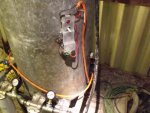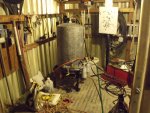Ford Mechanic
Active member
- 1,805
- 10
- 38
- Location
- Edenton, NC
I've got a good supply of free waste peanut oil that I want to use in my new M923. I was wondering if anyone else was using the same and what is the proceedure they are using to clean it? I already am using WMO for my M35 and would love to be able to use the same station with just a bit of cleaning and replacing the filters. The oil is coming out of a oil roaster for peanuts.
My existing station is a old well tank with a heater in it and a rack of 5 filters down to 2 microns for cleaning. Using air pressure to push the oil thru the filters.
Is there anything different about filtering waste peanut oil?
Before anyone complains about laws ..... I have a blenders license here in NC, so I'm doing it legally.
..... I have a blenders license here in NC, so I'm doing it legally.
Pics of my filter station



My existing station is a old well tank with a heater in it and a rack of 5 filters down to 2 microns for cleaning. Using air pressure to push the oil thru the filters.
Is there anything different about filtering waste peanut oil?
Before anyone complains about laws
 ..... I have a blenders license here in NC, so I'm doing it legally.
..... I have a blenders license here in NC, so I'm doing it legally.Pics of my filter station






